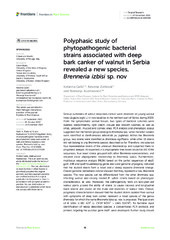Приказ основних података о документу
Polyphasic study of phytopathogenic bacterial strains associated with deep bark canker of walnut in Serbia revealed a new species, Brenneria izbisi sp. nov
| dc.creator | Gašić, Katarina | |
| dc.creator | Zlatković, Nevena | |
| dc.creator | Kuzmanović, Nemanja | |
| dc.date.accessioned | 2023-07-11T12:23:07Z | |
| dc.date.available | 2023-07-11T12:23:07Z | |
| dc.date.issued | 2022 | |
| dc.identifier.issn | 1664-462X | |
| dc.identifier.uri | https://plantarum.izbis.bg.ac.rs/handle/123456789/646 | |
| dc.description.abstract | Serious outbreaks of walnut deep bark canker were observed on young walnut trees (Juglans regia L.) in two localities in the northern part of Serbia during 2020. From the symptomatic walnut tissues, two types of bacterial colonies were isolated, predominantly, light cream, circular and smooth colonies, as well as small, yellowish, mucoid and convex ones. PCR analysis and phenotypic assays suggested that the former group belongs to Brenneria spp., while the latter isolates were identified as Xanthomonas arboricola pv. juglandis. Within the Brenneria group, two strains were identified as Brenneria nigrifluens, while other 15 strains did not belong to any Brenneria species described so far. Therefore, we selected four representative strains of the unknown Brenneria sp. and subjected them to polyphasic analysis. As expected, in a phylogenetic tree based on partial 16S rDNA sequences, four novel strains grouped with other Brenneria representatives, and showed close phylogenetic relationship to Brenneria salicis. Furthermore, multilocus sequence analysis (MLSA) based on the partial sequences of atpD, gyrB, infB and rpoB housekeeping genes and core-genome phylogeny indicated that the studied strains form a novel and a clearly separate Brenneria lineage. Overall genome relatedness indices showed that they represent a new Brenneria species. The new species can be differentiated from the other Brenneria spp. infecting walnut and closely related B. salicis strains based on phenotypic characteristics, as well. Moreover, the pathogenicity tests on two-year-old walnut plants proved the ability of strains to cause necrosis and longitudinal black lesions and cracks on the trunk and branches of walnut trees. Overall, polyphasic characterization showed that the studied strains isolated from walnut with symptoms of deep bark canker represent a novel species of the genus Brenneria for which the name Brenneria izbisi sp. nov. is proposed. The type strain of B. izbisi is KBI 423T (= CFBP 9035T = LMG 32479T). To facilitate rapid identification of newly described species, a conventional PCR protocol and primers targeting the putative gene hrpP, were developed. Further study should reveal the potential role of each pathogen isolated from symptomatic walnut in disease development as well as possible interaction between them. | sr |
| dc.language.iso | en | sr |
| dc.publisher | Frontiers Media | sr |
| dc.relation | info:eu-repo/grantAgreement/MESTD/inst-2020/200010/RS// | sr |
| dc.rights | openAccess | sr |
| dc.rights.uri | https://creativecommons.org/licenses/by/4.0/ | |
| dc.source | Frontiers in Plant Science | sr |
| dc.title | Polyphasic study of phytopathogenic bacterial strains associated with deep bark canker of walnut in Serbia revealed a new species, Brenneria izbisi sp. nov | sr |
| dc.type | article | sr |
| dc.rights.license | BY | sr |
| dc.citation.rank | aM21 | |
| dc.citation.volume | 13 | |
| dc.type.version | publishedVersion | sr |
| dc.identifier.doi | 10.3389/fpls.2022.1055186 | |
| dc.identifier.fulltext | http://plantarum.izbis.bg.ac.rs/bitstream/id/2700/bitstream_2700.pdf | |
| dc.identifier.scopus | 2-s2.0-85143508582 |


